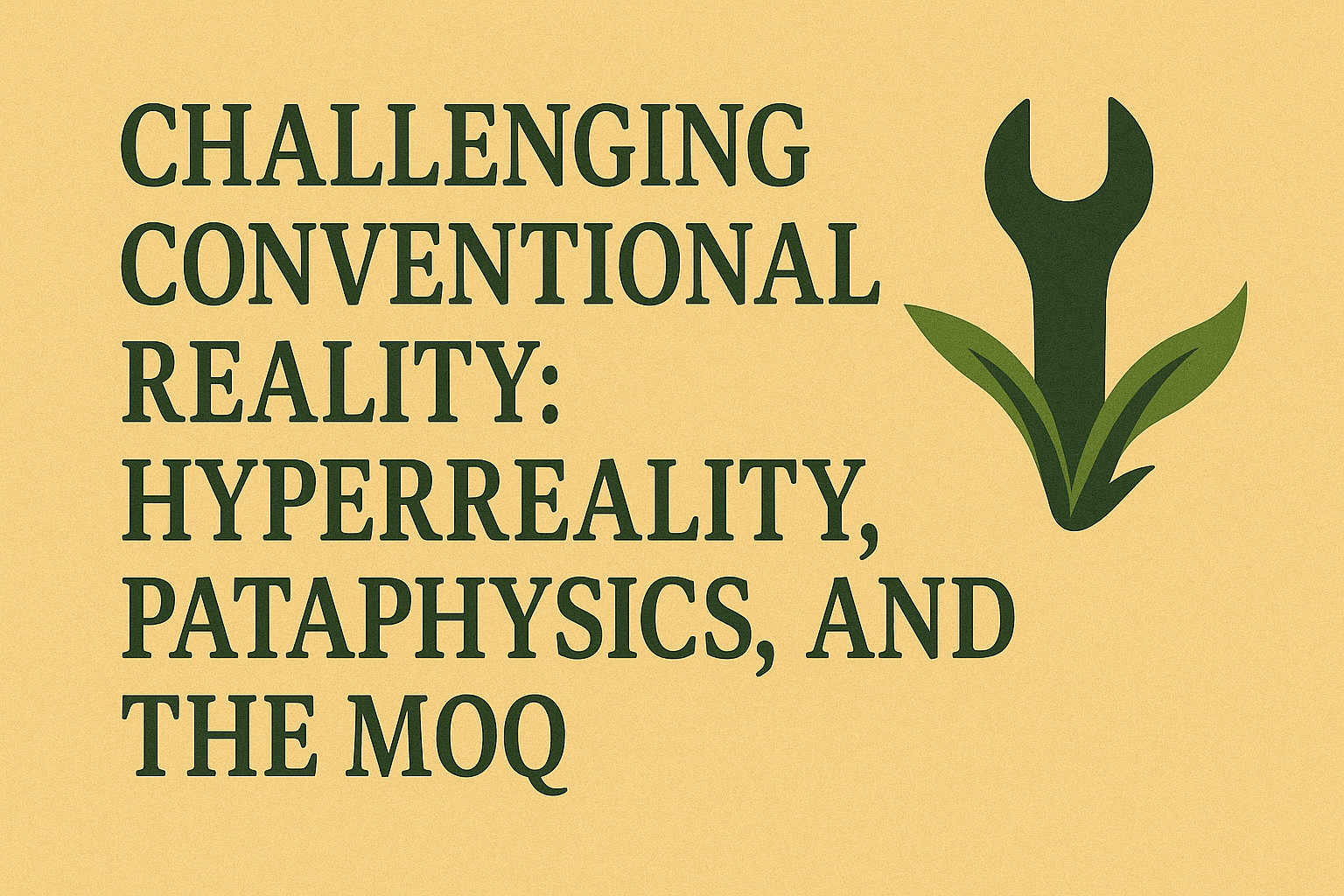Exploring how hyperreality and pataphysics challenge traditional notions of reality and their implications for the MoQ. Detailed analysis of how these philosophies question conventional reality, and their resonance with Pirsig’s critique of traditional rationality.
In a world where traditional notions of reality are increasingly questioned, the concepts of hyperreality and pataphysics offer fascinating frameworks for understanding and challenging conventional perceptions. These philosophies intersect intriguingly with Robert M. Pirsig’s Metaphysics of Quality (MoQ), providing a comprehensive critique of traditional rationality and opening new pathways for exploring reality. This article delves into how hyperreality and pataphysics challenge conventional reality and their implications for the MoQ, resonating with Pirsig’s philosophical inquiries.
Hyperreality: Beyond Conventional Reality
Hyperreality, a term popularized by the French sociologist and philosopher Jean Baudrillard, describes a condition where the distinction between reality and its representations becomes blurred. In hyperreality, symbols and simulations take precedence over the actual, creating a reality that is more real than the real.
- Simulacra and Simulation: Baudrillard’s concept of simulacra refers to copies or representations that either have no original or surpass the original. These simulations create a hyperreal world where images and signs become more significant than the physical reality they represent.
- Example: Theme parks like Disneyland create hyperreal environments where idealized versions of reality replace the actual. Visitors experience a curated reality designed to be more appealing and engaging than the everyday world.
- Media and Technology: The proliferation of media and technology plays a crucial role in constructing hyperreality. Advertisements, virtual reality, and digital platforms shape our perceptions and experiences, often leading to a detachment from tangible reality.
- Example: Social media platforms present curated and filtered versions of life, influencing how individuals perceive their own and others’ realities. This creates a hyperreal environment where digital representations often hold more sway than actual experiences.
Pataphysics: The Science of Imaginary Solutions
Pataphysics, a pseudo-scientific philosophy developed by the French writer Alfred Jarry, explores imaginary solutions and the laws governing exceptions rather than rules. It embraces the absurd, the whimsical, and the unconventional, providing a stark contrast to traditional scientific and philosophical thought.
- Imaginary Solutions: Pataphysics posits that reality includes imaginary and absurd dimensions that challenge conventional logic and perception. It explores possibilities beyond empirical observation and rational consistency.
- Example: Jarry’s character, Doctor Faustroll, embodies pataphysical thinking by navigating a world governed by imaginary solutions and absurd logic, challenging the boundaries of conventional reality.
- Beyond Metaphysics: Jarry described pataphysics as existing “beyond metaphysics,” implying a transcendent approach that embraces fluidity and imagination over rigid structures.
- Example: Pataphysical art and literature often employ surreal and nonsensical elements to provoke thought and challenge conventional interpretations of reality.
The Metaphysics of Quality (MoQ) and Traditional Rationality
Robert M. Pirsig’s Metaphysics of Quality challenges traditional rationality by positing quality as the fundamental reality. Pirsig divides quality into static and dynamic categories, each playing a crucial role in understanding and engaging with the world.
- Static Quality: Represents the structured, ordered aspects of life, encompassing traditions, norms, and established patterns that provide stability.
- Example: In Zen and the Art of Motorcycle Maintenance, Pirsig discusses the importance of technical precision and adherence to established maintenance routines, which exemplify static quality.
- Dynamic Quality: Embodies the creative, changing forces that drive innovation and progress, transcending static patterns and encouraging continuous growth.
- Example: Pirsig’s journey of personal and philosophical exploration in Lila represents dynamic quality, as he seeks new understandings and challenges existing paradigms.
Resonance with Hyperreality and Pataphysics
Both hyperreality and pataphysics resonate with Pirsig’s critique of traditional rationality by questioning the boundaries of conventional reality and emphasizing the importance of imagination and perception.
- Challenging Conventional Reality: Hyperreality and pataphysics disrupt traditional notions of reality by highlighting the influence of symbols, simulations, and the absurd.
- Hyperreality: Challenges the primacy of tangible reality by demonstrating how mediated experiences shape our understanding of the world.
- Pataphysics: Encourages imaginative thinking and the exploration of possibilities beyond rational constraints, aligning with dynamic quality’s emphasis on creativity and innovation.
- Integration with MoQ: The integration of hyperreality and pataphysics with the MoQ offers a more nuanced understanding of reality that incorporates both static and dynamic quality.
- Static Quality: Recognizes the importance of structured, stable elements in maintaining order and continuity.
- Dynamic Quality: Embraces the imaginative and transformative aspects of hyperreality and pataphysics, fostering a holistic view of reality that transcends conventional boundaries.
Case Studies and Examples
- Art and Media: The influence of hyperreality and pataphysics is evident in contemporary art and media, where artists and creators use these concepts to challenge viewers’ perceptions and provoke critical thought.
- Example: The works of Salvador Dalí, with their surreal and dreamlike qualities, embody pataphysical principles by defying logical interpretation and inviting imaginative engagement.
- Example: Modern films like The Matrix explore hyperreality by questioning the nature of reality and the influence of simulations on human perception.
- Education and Critical Thinking: Incorporating the principles of hyperreality and pataphysics into education can enhance critical thinking and creativity, encouraging students to question conventional wisdom and explore alternative perspectives.
- Example: Educational programs that use interactive simulations and role-playing scenarios help students understand complex concepts by engaging with hyperreal environments.
- Example: Creative writing courses that encourage students to embrace absurdity and imagination foster dynamic quality and innovative thinking.
Conclusion
Hyperreality and pataphysics challenge traditional notions of reality by emphasizing the importance of symbols, simulations, and the absurd. These philosophies resonate with Robert M. Pirsig’s Metaphysics of Quality, particularly the dynamic quality that values creativity and innovation. By integrating the insights from hyperreality and pataphysics, we can achieve a more comprehensive understanding of reality that transcends conventional boundaries. This holistic approach fosters critical thinking, creativity, and a deeper appreciation of the complex interplay between perception and reality, ultimately enriching our engagement with the world.
